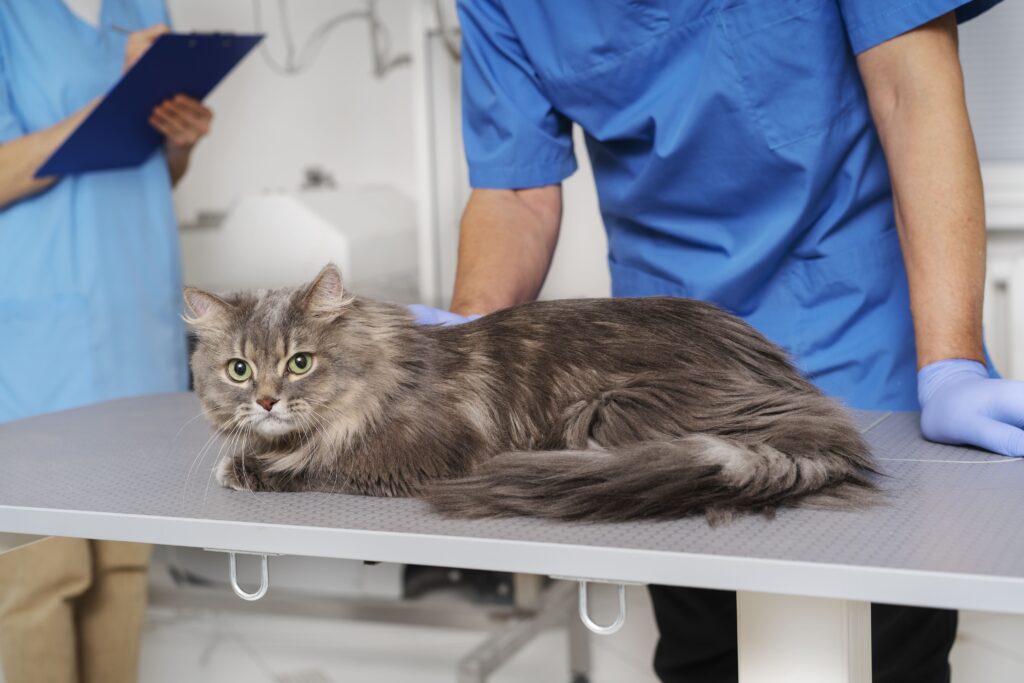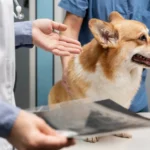
Contents
- 1 What Is a Cat Leg Fracture?
- 2 Common Causes of Leg Fractures in Cats
- 3 Symptoms to Watch For
- 4 Sprain vs. Fracture
- 5 Immediate First Aid
- 6 When to Seek Emergency Care
- 7 How Veterinarians Diagnose
- 8 Treatment Options
- 9 Home Care & Recovery
- 10 Nutrition for Bone Healing
- 11 Preventing Future Injuries
- 12 Conclusion
- 13 FAQs
Cats are agile and graceful, but accidents can happen in an instant. Whether your feline companion is a street cat navigating traffic, a curious indoor cat exploring high shelves, or a playful kitten caught in a reclining chair, cat leg fractures are a serious concern. Early recognition of cat leg fracture symptoms can prevent severe complications, such as malunion, infection, or chronic mobility issues. Prompt action ensures your cat receives the right care, reduces pain and speeds up recovery. This guide will cover causes of leg fractures, symptoms to watch for, immediate first aid, treatment options, nutrition for bone healing and prevention strategies to keep your cat safe.
What Is a Cat Leg Fracture?
A cat leg fracture is a serious injury that occurs when one of the cat’s bones in the limb breaks. Fractures can range from a simple crack to a complete break where the bone pierces the skin. Understanding cat leg fracture symptoms is critical for pet owners to prevent complications, which may include malunion (bones healing incorrectly), infection or chronic pain.
There are several types of fractures:
- Open fracture: The bone breaks through the skin, increasing the risk of infection.
- Closed fracture: The bone is broken but the skin remains intact.
Early detection and treatment of limb fractures are crucial. Prompt veterinary care ensures proper alignment, reduces pain and prevents complications such as abnormal bone healing or joint stiffness.
Common Causes of Leg Fractures in Cats
Cats are agile and resilient, but their curious nature and interactions with the environment make them prone to injuries. Common causes of fractures include:
- Vehicular trauma: Being struck by a car or motor vehicle is one of the leading causes of leg fractures in cats. The force from a collision can lead to severe fractures, internal injuries or even life-threatening complications.
- High-rise syndrome: Cats falling from high places, such as balconies or windows, can sustain fractures to the limbs or pelvis. This is especially common in urban areas where cats have access to elevated spaces.
- Bite wounds: Encounters with other animals, particularly street cats, may result in deep bites that fracture bones.
- Projectile injuries: Bullet injuries, arrow injuries, pellet gun injuries and slingshot injuries are rare but serious causes of leg fractures.
- Household injuries: Cats can get their limbs caught in reclining chairs or trapped under heavy furniture, causing broken bones.
Street cat populations are at higher risk due to environmental hazards, fights and a lack of immediate access to veterinary care.
Symptoms to Watch For
Recognizing cat leg fracture symptoms early can save your cat from prolonged pain and prevent long-term complications. Key signs include:
1. Limping or Non-Weight Bearing
When a cat suffers a broken leg or limb fracture, it may completely avoid using the injured limb, keeping it raised or dragging it awkwardly. This is one of the earliest and most obvious signs of injury.
2. Restricted Mobility
A fractured leg causes limited mobility, your cat may hesitate to walk, jump, or climb. Even routine activities like using the litter box or jumping onto furniture may become difficult, signaling pain and potential skeletal damage needing attention.
3. Swelling or Deformity
Fractures often result in visible swelling around the affected area. The leg might look bent at an unnatural angle, twisted, or even dangle loosely. This physical deformity is a strong indication of bone misalignment or severe trauma.
4. Open Wounds
An open fracture occurs when bone pierces the skin, exposing tissue and increasing infection risk. Immediate veterinary care is crucial in such cases to clean the wound, start antibiotics, and stabilize the bone to prevent further complications.
5. Pain Vocalization and Behavioral Changes
Cats in pain may cry, hiss, growl, or become unusually aggressive when touched. Others withdraw, hide, or refuse interaction. These behavioral shifts are the cat’s way of signaling distress and should not be ignored.
Sprain vs. Fracture
It’s important to distinguish between soft-tissue injuries like sprains and actual bone fractures:
- Sprains: Sprains affect ligaments rather than bones and usually cause mild swelling and discomfort. Cats can often still bear some weight on the leg, though their gait may be altered, and they may be reluctant to jump or run.
- Fractures: Fractures involve an actual break in the bone, leading to severe pain, significant swelling, visible deformity, or a dangling limb. Cats with fractures often refuse to put any weight on the leg, indicating an urgent medical problem.
Because sprains and fractures can look similar, it’s safest to treat every serious limping episode as a possible broken leg. Prompt veterinary care, including sedation and X-ray, ensures proper diagnosis and prevents complications from delayed treatment.
Immediate First Aid
After noticing cat leg fracture symptoms, your primary goal is to keep the cat calm and reduce stress hormones, which can exacerbate pain. Here’s how:
- Keep your cat calm: Stress increases stress hormones, which can worsen pain and delay healing.
- Safe handling and transport: Use a sturdy carrier or create a temporary stretcher with a flat surface and blanket. Avoid sudden movements.
- Avoid DIY splints: Homemade splints can cause further damage or restrict circulation. Only a veterinarian should apply immobilization devices.
When to Seek Emergency Care
Seek immediate veterinary care if your cat exhibits:
- Severe pain, open fractures, visible bone or heavy bleeding
- Projectile injuries (bullets, arrows, pellets) or crush trauma
- Signs of shock, pale gums, or unresponsiveness
Delaying treatment increases the risk of infection, improper healing, and long-term mobility issues.
How Veterinarians Diagnose
At the clinic, veterinarians will:
- Perform a physical examination: Assess limb stability, swelling, and pain response.
- Sedation for safe handling: Helps ensure accurate examination and prevents additional injury.
- X-ray imaging: Confirms fracture type (open vs. closed) and severity, guiding treatment decisions.
Additional diagnostics may be used to check for other injuries, especially in cats involved in vehicular accidents or falls.
Treatment Options
Splints, Casts and Splint Replacement
For mild or stable fractures, vets may use splints or casts. These immobilize the leg while allowing proper healing. Swelling often decreases over time, requiring splint replacements or adjustments. Regular follow-up visits ensure that the splint fits correctly, circulation is normal, and healing is progressing as planned. At home, monitor for discomfort, excessive licking, or restricted movement, and report any concerns promptly.
Surgery
Severe fractures often require surgical intervention to restore proper bone alignment:
- Pins or plates: Internal fixation holds the bone fragments together, preventing malunion.
- External fixators: Stabilize the fracture externally, allowing limited movement while maintaining alignment.
Post-surgery care involves pain management, restricted activity, and monitoring the surgical site for signs of infection.
Pain Management and Antibiotics
Open fractures or surgical procedures may require antibiotics to prevent infection. Pain medications can include oral pills, injections, or transdermal options, which are applied to the skin for cats that resist oral medications. Consistent administration is key to comfort and healing.
Home Care & Recovery
After veterinary treatment:
- Cage rest and restricted mobility: Essential to prevent re-injury.
- Incision care: Keep surgical wounds clean and monitor for signs of infection.
- Recovery collar: Prevents the cat from licking or biting the surgical site.
- Follow-up visits: Ensure proper bone healing and check for complications.
Monitoring your cat for swelling, redness or discharge during healing is vital. Promptly contact the vet if you notice any concerning changes.
Nutrition for Bone Healing
Nutrition plays a vital role in recovery from cat leg fractures. A diet rich in protein, calcium and phosphorus supports bone repair and overall health.
- Protein: Repairs tissues and maintains muscle mass during immobilization.
- Calcium and phosphorus: Strengthen bones and promote proper healing.
- Feline-specific diets: Commercial foods formulated for growth or recovery ensure the right nutrient balance.
Feeding Tips:
- Serve smaller, frequent meals to maintain appetite and energy levels.
- Monitor weight, as restricted mobility may reduce activity and increase the risk of weight gain.
- Provide fresh water at all times.
Proper nutrition enhances the healing process and helps restore mobility.
Preventing Future Injuries
Preventing fractures in the future involves:
- Cat-proof your home: Avoid hazards like reclining chairs, loose wires, or heavy furniture that can trap limbs.
- Supervised outdoor time: Limit outdoor exposure to traffic and aggressive animals.
- Safe climbing spaces: Provide cat trees or shelves with secure landings to reduce the risk of high-rise injuries.
Conclusion
Recognizing cat leg fracture symptoms early and acting quickly can make all the difference in your cat wound treatment. From immediate first aid to professional treatment, proper nutrition and preventive measures, every step plays a vital role in restoring mobility and comfort.
At North MS Pet Emergency, we provide 24/7 expert care for all pet emergencies, including fractures. Don’t wait, contact us immediately if your cat shows signs of a broken leg. Quick intervention prevents complications, ensures proper healing, and gives your cat the best chance for a full, healthy recovery.
FAQs
1. What are the common cat leg fracture symptoms and treatment options?
Common cat leg fracture symptoms include limping, swelling, deformity, inability to bear weight, and vocalizing pain. Treatment often involves splints, casts, or surgery, combined with pain management, restricted activity, and follow-up veterinary care to ensure proper healing.
2. My cat has a broken leg and I have no money. What should I do?
If your cat has a broken leg and funds are limited, contact local animal shelters, charitable veterinary clinics, or veterinary assistance programs. Prompt care is critical, as untreated fractures can worsen, leading to infection, malunion, or permanent mobility issues.
3. Can I treat a cat with a broken leg at home?
You should never attempt to fully treat a cat’s broken leg at home. Temporary immobilization for transport is acceptable, but DIY splints or medications can worsen fractures. Immediate veterinary care is essential for proper alignment, pain management, and healing.
4. How can I tell if my cat’s leg is broken or just sprained?
Signs of a broken leg include severe limping, swelling, visible deformity, non-weight bearing, and vocalizing pain. Sprains may allow limited movement, minor swelling, and mild discomfort. When in doubt, assume a fracture and seek emergency veterinary care.
5. Can a cat’s broken leg heal by itself, and how fast is it dangerous?
A cat’s broken leg will rarely heal properly without treatment. Untreated fractures can cause chronic pain, infection, or malunion. Severe fractures can lead to complications affecting mobility or overall health. Immediate veterinary attention is necessary to prevent life-threatening outcomes.




